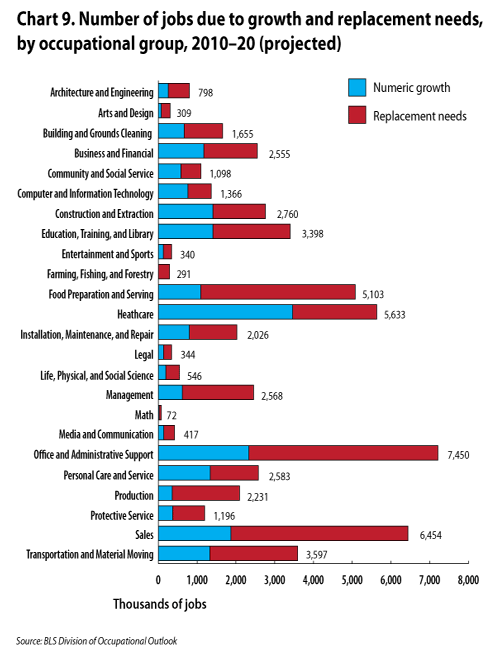 In recent weeks, oil field services companies have made some pretty big headlines with announcements of major reductions in employees as the price of oil continues to slide. Many of these announcements do not identify the actual numbers of those employees who live in the United States. For those who do, however, the future may not be as bleak as one might think. We are here with a solution.
In recent weeks, oil field services companies have made some pretty big headlines with announcements of major reductions in employees as the price of oil continues to slide. Many of these announcements do not identify the actual numbers of those employees who live in the United States. For those who do, however, the future may not be as bleak as one might think. We are here with a solution.
The US construction market is poised to have one of the best growth periods since the early 1970’s. Many believe this renaissance could restore the United States to a position of manufacturing prominence that was lost over the last two decades. The risk to fulfilling this promising destiny is not one of projects delayed or cancelled because of oil prices, but rather one of projects delayed or cancelled because engineers, architects and constructors fail to find the talented people required to deliver the work as planned.
Many noteworthy institutions have published studies and commentary about how the future of the construction industry is insulated from the turmoil surrounding oil prices and the factors and motivations of those whose actions – or lack thereof – cause world reaction and fear about the future of oil-related markets. Among them is the University of Houston’s Bauer College of Business whose “Institute for Regional Forecasting” continues to reinforce the independence of the construction boom from the volatility of oil pricing. Groups like Alpha Resources, LLC of Birmingham, Alabama and Industrial Information Resources Inc. from Houston say the same thing.
All these predictions are driven by analysis of announced projects and capital expenditures of manufacturers, midstream companies and refining and chemical companies. But they all seem to neglect another important factor adding to the pending shortage of talent in the construction industry: pending retirements of current employees.
 The Bureau of Labor Statistics graph on the right displays, by industry, the number of jobs from growth and the number of jobs from replacements (retirees). This is important to understand because if these crystal ball forecasts prove to be only 30 to 50% accurate, the construction industry will still have a talent deficiency. The difference is that the industry would move from having a shortfall of 100,000 to 150,000 craft professionals along the Gulf Coast alone to a small number, but still one that will be a challenge.
The Bureau of Labor Statistics graph on the right displays, by industry, the number of jobs from growth and the number of jobs from replacements (retirees). This is important to understand because if these crystal ball forecasts prove to be only 30 to 50% accurate, the construction industry will still have a talent deficiency. The difference is that the industry would move from having a shortfall of 100,000 to 150,000 craft professionals along the Gulf Coast alone to a small number, but still one that will be a challenge.
Let’s be clear: The construction industry has not been sitting idle over the last few years as this pending labor shortage was simmering.
“Workforce Development” has become a battle cry for many industrial service providers, owners, academic institutions and private training organizations. However, similar to our federal government, efforts have been stymied by unintended barriers for potential skilled applicants’ ability to find jobs or for unskilled or semi-skilled applicants to understand the requirements between training and experience necessary to be hired. Aggravating that dysfunction are debates over who pays, lack of circular coordination among high schools and academic institutions and politics on the part of the contractor community concerned over the loss of proprietary training programs.
The majority of workforce development efforts have targeted kindergarten through 12th grade students with a focus on community college technical training. While all of these are admirable initiatives and represent the sustainable solution to a deficiency in talent availability in the long term, they all neglect the fact that the construction industry needs help right this minute. Many approved projects cannot wait a few years for those students to show up at hiring offices of engineering and construction companies. What’s missing is a balance of focus on the underemployed and the displaced workforce like those who are being separated from the oil services industry or who will be displaced soon.
Our industry must address our image. Training alone will not likely solve our problem. Many do not understand the financial rewards of the commercial or industrial construction segments, nor do they understand the safety commitment and safe performance in our industry.
We have to tell our story.
What our industry needs is a one stop shop, where we create an intersection between those interested in starting or maintaining a career in construction with those who hire and those who train. The process needs to be elegant and simple, built from the perspective of those looking for work instead of those looking to hire or looking to train. There should be an intuitive process for a person to either gain skills and experience or re-tool their skills so that they can transition from a similar industry or craft. We need a process where the craft professional can take ownership of his or her development direction and pace of progression. Such a process will require construction firms to focus on enabling the craft professional to fulfill progression toward a career and not just completion of a project.
Fortunately, we have such a process under development via the Construction Citizen website called Craft Careers.
We are on the verge of making history for the construction industry as we move toward more transparency between those who aspire to be craft professionals, those who are currently craft professionals looking to gain greater skills and move into more challenging roles, construction employers, owners, professional training firms and academia providing training and development. While the Craft Careers section is not yet complete, it is well-developed and can provide a lot of information to those who know little of the industry and need to explore opportunities and for those who have experience in similar industries and need to develop a plan to transition into construction.
This brings us full circle to many of those displaced or soon-to-be displaced employees in the oil field services industry: WE NEED YOU NOW!
Check out the Craft Careers section for more information.


